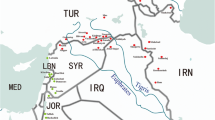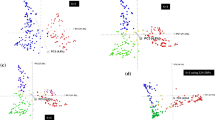Abstract
The modern plant breeding is generally considered to be a practice that leads to a narrowing in genetic diversity of crops. The objective of the present study was to assess whether this practice has led to the reduction of genetic diversity in modern Chinese wheat cultivars. A set of 80 dominant Chinese wheat cultivars released from 1942 to 2011 was used to describe the genetic diversity based on 137 simple sequence repeat (SSR) and 52 functional markers. Several important properties about the genetic diversity were revealed. First, relative low genetic diversity level was detected on a genome-wide scale. A total of 752 alleles were detected with a range from 1 to 15, and the mean polymorphic information content value was 0.53 with a range from 0.00 to 0.87. Second, the genetic diversity significantly decreased from 2001 to 2011 at the genome-wide level. More importantly, significant differences of genetic diversity among the three different genomes were observed by the analysis of variance (ANOVA). The three genomes had clearly different changing trends over time: the A genome displayed a decreasing trend (regression coefficient (b) = −0.01); in contrast, the other two genomes, B and D, showed the increasing trends (b = 0.01 for the B genome, P = 0.05; b = 0.01 for the D genome, P = 0.05). Third, the analysis of qualitative variations in allelic composition over time indicated that, the more recent the cultivars were, the more similar they were to each other. Finally, the frequencies of favorable alleles related to important agronomic traits had been increasing over time or maintained high frequencies in all seven temporal groups. These findings indicate that modern wheat breeding results in not only a qualitative, but also a quantitative change in genetic diversity in the dominant Chinese wheat cultivars. A special attention should be paid to broaden the genetic base in the A genome.



Similar content being viewed by others
References
Breseghello F, Sorrells ME (2006) Association mapping of kernel size and milling quality in wheat (Triticum aestivum L.) cultivars. Genetics 172:1165–1177
Brown WL (1983) Genetic diversity and genetic vulnerability-an appraisal. Econ Bot 37:4–12
Chao S, Zhang W, Dubcovsky J, Sorrells M (2007) Evaluation of genetic diversity and genome-wide linkage disequilibrium among U.S. wheat (Triticum aestivum L.) germplasm representing different market class. Crop Sci 47:1018–1030
Chen X, Min D, Yasir TA, Hu YG (2012) Genetic diversity, population structure and linkage disequilibrium in elite Chinese winter wheat investigated with SSR markers. PLoS ONE 7:e44510
Christiansen MJ, Andersen SB, Ortiz R (2002) Diversity changes in an intensively bred wheat germplasm during the 20th century. Mol Breed 9:1–11
Donini P, Law JR, Koebner RM, Reeves JC, Cooke RJ (2000) Temporal trends in the diversity of UK wheat. Theor Appl Genet 100:912–917
Eills MH, Spielmeyer W, Gale KR, Rebetzke GJ, Richards RA (2002) “Perfect” markers for the Rht-B1b and Rht-D1b dwarfing genes in wheat. Theor Appl Genet 105:1038–1042
Fu YB, Somers DJ (2009) Genome-wide reduction of genetic diversity in wheat breeding. Crop Sci 49:161–168
Fu YB, Peterson GW, Scoles G, Rossnagel B, Schoen DJ, Richards KW (2003) Allelic diversity changes in 96 Canadian oat cultivars released from 1886 to 2001. Crop Sci 43:1989–1995
Guo X, Gao A, Liu W, Yang X, Li X, Li L (2011) Evaluation of genetic diversity, population structure, and linkage disequilibrium among elite Chinese wheat (Triticum aestivum L.) cultivars. Aust J Crop Sci 5:1167–1172
Guo XR, Wang YY, Meng LZ, Liu HW, Yang L, Zhou Y, Zhang HJ (2015) Distribution of the Vrn-D1b allele associated with facultative growth habit in Chinese wheat accessions. Euphytica 206:1–10
Hao C, Wang L, Ge H, Dong Y, Zhang X (2011) Genetic diversity and linkage disequilibrium in Chinese bread wheat (Triticum aestivum L.) revealed by SSR markers. PLoS ONE 6:e17279
He XY, He ZH, Zhang LP, Sun DJ, Morris CF, Fuerst EP, Xia XC (2007) Allelic variation of polyhenol oxidase (PPO) genes located on chromosomes 2A and 2D and development of functional markers for the PPO genes in common wheat. Theor Appl Genet 115:47–58
Hogg AC, Beecher B, Martin JM, Meyer F, Talbert L, Lanning S, Giroux MJ (2005) Hard wheat milling and bread baking traits affected by the seed-specific overexpression of puroindolines. Crop Sci 45:871–878
Huang XQ, Wolf M, Canal MW, Orford S, Koebner RMD, Röder MS (2007) Did modern plant breeding lead to genetic erosion in European winter wheat varieties? Crop Sci 47:343–349
Landjeva S, Korzun V, Ganeva G (2006) Evaluation of genetic diversity among Bulgarian winter wheat (Triticum aestivum L.) varieties during the period 1925–2003 using microsatellites. Genet Resour Crop Evol 53:1605–1614
Liang D, Tang JW, Pena RJ, Singh R, He XY, Shen XY, Yao DN, Xia XC, He ZH (2010) Characterization of CIMMYT bread wheats for high- and low-molecular weight glutenin subunits and other quality-related genes with SDS-PAGE, RP-HPLC and molecular markers. Euphytica 172:235–250
Ling HQ, Zhang S, Liu D, Wang J, Sun H, Zhang C, Fan H, Li D, Dong L, Tao Y, Gao C, Wu H, Li Y, Cui Y, Guo X, Xheng S, Wang B, Yu K, Liang Q, Yang W, Liu X, Cheng J, Feng M, Jian J, Zhang X, Luo G, Jiang Y, Liu J, Wang Z, Sha Y, Zhang B, Wu H, Tang D, Shen Q, Xue P, Zou S, Wang X, Liu X, Wang F, Yang Y, An X, Dong Z, Zhang K, Zhang X, Luo MC, Dvorak J, Tong Y, Wang J, Yang H, Li Z, Wang D, Zhang A, Wang J (2013) Draft genome of the wheat A-genome progenitor Triticum urartu. Nature 496:87–90
Liu K, Muse SV (2005) PowerMarker: an integrated analysis environment for genetic marker analysis. Bioinformatics 21:2128–2129
Liu Y, He Z, Appels R, Xia X (2012) Functional markers in wheat: current status and future prospects. Theor Appl Genet 125:1–10
Luo C, Griffin WB, Branlard G, McNeil DL (2001) Comparison of low- and high- molecular-weight wheat glutenin allele effects on flour quality. Theor Appl Genet 102:1088–1098
Murray M, Thompson WF (1980) Rapid isolation of high molecular weight plant DNA. Nucleic Acids Res 8:4321–4326
Peng JH, Sun DF, Nevo E (2011) Domestication evolution, genetics and genomics in wheat. Mol Breed 28:281–301
Peng Q, Dai S, Guo Q, Cheng D, Li H, Liu A, Liu J, Zhao S, Song J (2012) The evolution of genetic diversity of wheat varieties released in Shandong province since 1950. Mol Plant Breed 10:228–237
Rasheed A, Xia X, Mahmood T, Quraishi UM, Aziz A, Bux H, Mahmood Z, Mirza JI, Mujeeb-Kazi A, He Z (2015) Comparison of economically important loci in landraces and improved wheat cultivars from Pakistan. Crop Sci 56:1–15
Roussel V, Koenig J, Beckert M, Balfourier F (2004) Molecular diversity in French bread wheat accessions related to temporal trends and breeding programmes. Theor Appl Genet 108:920–930
Roussel V, Leisova L, Exbrayat F, Stehno Z, Balfourier F (2005) SSR allelic diversity changes in 480 European bread wheat varieties released from 1840 to 2000. Theor Appl Genet 111:162–170
Sun DJ, He Zh, Xia CX, Zhang LP, Morris CF, Appels R, Ma WJ, Wang H (2005) A novel STS marker for polyphenol oxidase activity in bread wheat. Mol Breed 16:209–218
Tanksley SD, McCouch SR (1997) Seed banks and molecular maps: unlocking genetic potential from the wild. Science 277:1063–1066
Tian QZ, Zou RH, Jia JZ (2005) Gnetic diversity trend of common wheat (Triticum aestivum L.) in China revealed with AFLP merkers. Genet Resour Crop Evol 52:325–331
Vellvé R (1993) The decline of diversity in European agriculture. Ecologist 23:64–69
Wouw M, Hintum T, Kik C, Treuren R, Visser B (2010) Genetic diversity trends in twentieth century crop cultivars: a meta analysis. Theor Appl Genet 120:1241–1252
Zhang X, Yang S, Zhou Y, He ZH, Xia XC (2006) Distribution of the Rht-B1b, Rht-D1b and Rht8 reduced height genes in autumn-sown Chinese wheats detected by molecular markers. Euphytica 152:109–116
Zhang LY, Liu DC, Guo XL, Yang WL, Sun JZ, Wang DW, Sourdille P, Zhang AM (2011) Investigation of genetic diversity and population structure of common wheat cultivars in northern China using DArT markers. BMC Genet 12:42
Zhuang QS (2003) Chinese wheat improvement and pedigree analysis. China Agriculture Press, Beijing
Acknowledgements
The authors thank Dr. CY Hao and YG Xiao, Institute of Crop Sciences, Chinese Academy of Agricultural Sciences, Beijing, China, and Dr. GH Yin, Zhoukou Academy of Agricultural Sciences, Henan, China, for generously providing parts of wheat cultivars. This study was supported by the National Natural Science Foundation of China (31401468).
Author information
Authors and Affiliations
Corresponding authors
Ethics declarations
Conflict of interest
The authors declare that they have no conflict of interest.
Additional information
Lingzhi Meng and Chao Xiang are Co-first authors.
Electronic supplementary material
Below is the link to the electronic supplementary material.
Rights and permissions
About this article
Cite this article
Meng, L., Xiang, C., Liu, H. et al. The impact of modern plant breeding on dominant Chinese wheat cultivars (Triticum aestivum L.) revealed by SSR and functional markers. Genet Resour Crop Evol 65, 55–65 (2018). https://doi.org/10.1007/s10722-017-0508-2
Received:
Accepted:
Published:
Issue Date:
DOI: https://doi.org/10.1007/s10722-017-0508-2




